|
Pictorial History of the Ski, Invented Before the Wheel
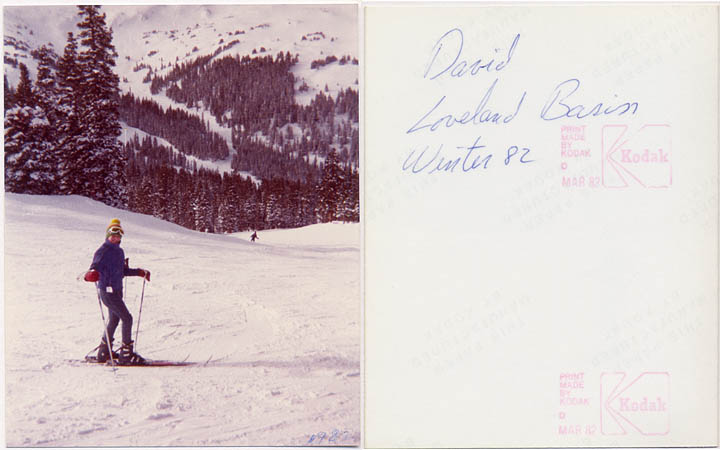
Taken by my father with a small Kodak Ektra 110 film camera, the author skis as a kid in Levi's jeans and second hand equipment at Loveland Basin in February, 1982, Colorado. |
As a Colorado native, I have always felt a close kinship to the state's mountains and of course to its winters, filled with wonderfully steep and deep powder filled basins and backcountry. In the late 1960s, my parents enjoyed skiing at the easy-to-drive-to Loveland Basin. I also learned to ski there and was soon visiting many of the front range ski areas like Eldora, Copper Mountain and Mary Jane with family and friends. On groomed slopes, I improved my skiing ability and also picked up snowboarding in the 1990s after it was introduced. Later, I learned to telemark on long, skinny, cross country skis, again at Loveland. Eventually, I took a few backcountry hut trips with work friends and crossed avalanche prone valleys to climb and descend untouched snow filled mountains while staying in warm and comfy cabins overnight.
For many years, I would purchase an annual Loveland pass for the week and tele only after big snows while avoiding the Friday and weekend traffic and crowds. Later still, I would forego any lift tickets and strap on the skins and climb the hills in blizzard conditions and glide down the powdery slopes of places like Berthoud Pass. The more climbing I did with skins, the more I began to question the origins of the sport. The following is some of what I found.

Near the Arctic Circle, parts of ancient skis were Carbon-14 dated to approximately 8000 years old. The artifacts were recovered from a peat bog from the Vis excavations in northwest Russia in the Komi Republic. (Photo from ResearchGate PDF) |

Detailed drawings and photos show the moose nosed carving once used as a brake on the rear of the ski. Archaeologist Grigory M. Burov dug in peat bogs along the historical river courses along the Vis and Simva Rivers near the village of Sindor and Lake Sindor. (Photo from ResearchGate PDF) |
This is some of the earliest evidence of the use of the ski. Yet, in an international and now political competition to be the first country to develop the ski, China has located a cave in the Altay Mountains with skier pictographs. They used the discovery to promote their hosting of the 2022 Winter Olympics and have experts that claim they are 10,000 years old, but have not provided any carbon-dating evidence to support their theory. Yet, some are seeing the possibility of antiquity.
"And while international scholars and historians are slowly coming around to the idea that sliding on snow may have indeed originated here instead of the Scandinavian mountains that were long considered its cradle, a deeper battle over skiing’s origins is already being waged within China’s own borders. It is a struggle marked by fears that ethnic minorities like the Mongols and Kazakhs who have long lived in the these mountains will have their way of life choked off by encroaching modernity — and the country’s ethnic Han Chinese majority, which dominates a government that has had no qualms shaping Chinese culture in its own image."
"The ethnic Han “never used these boards, yet they are claiming an attachment to it,” said a traditional skier who flies the flag of Kazakhstan over his family’s log home in Khom, the village that shares its name with the river that runs through this valley. “Maybe it’s a national pride thing, but in reality it’s our ancestors that were doing it.” (source NY Times 4/19/17 and reprinted at OSU's MCLC)
Political motivations aside, much of the tangible evidence points to the Scandinavian countries as well as Russia and China independently developing their own early versions of the ski throughout time, more as a necessity and as a method of winter travel and hunting rather than for sport.
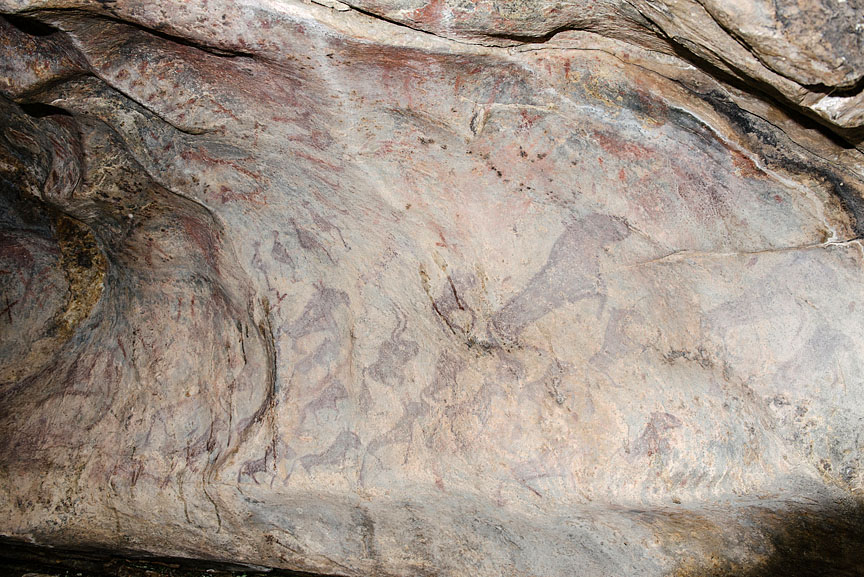
In a cave located in China's in Xinjiang Province, petroglyph skiers hunt ibex and painted skiers stand above ice age mammals and what looks like extinct aurochs. The petroglyphs and pictogrpahs have not been carbon-dated, but are they at least 10,000 year old? (Photo Credit: Garrett Grove - photo from the Ohio State University's MCLC Rescource Center website) |

Due west of the Vis excavations, still in northwest Russia near the town of Belomarsk, Archaeologist Nadezhda Lobanova from the Karelian Research Centre in Petrozavodsk points out a 4,000 year old panel of the Zalavruga Petroglyphs where prehistoric hunters with bow and arrows track and shoot reindeer or moose. Her finger is at the start of the hunter's parallel ski tracks which flows off to the lower right. (photo from Wikimedia Commons) |
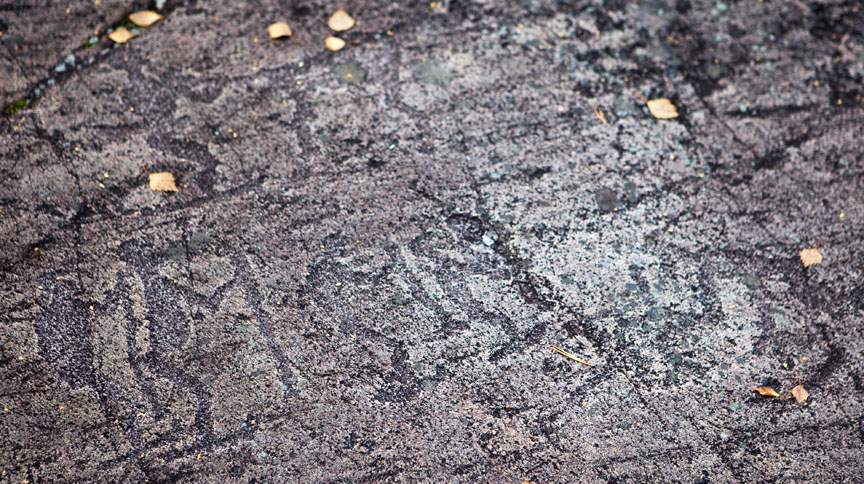
More of the Zalavruga Petroglyphs with prehistoric skiers with poles. (photo from Wikimedia Commons) |

In 1895, William Henry Jackson photographed a Russian, Siberian resident on the ice. His description was "Goldes hunter on skis on ice floe, with spear and rifle." Much of the early use of skis was for hunting and would have looked much like Jackson's photo, substituting a bow for the rifle. (photo from Library of Congress) |
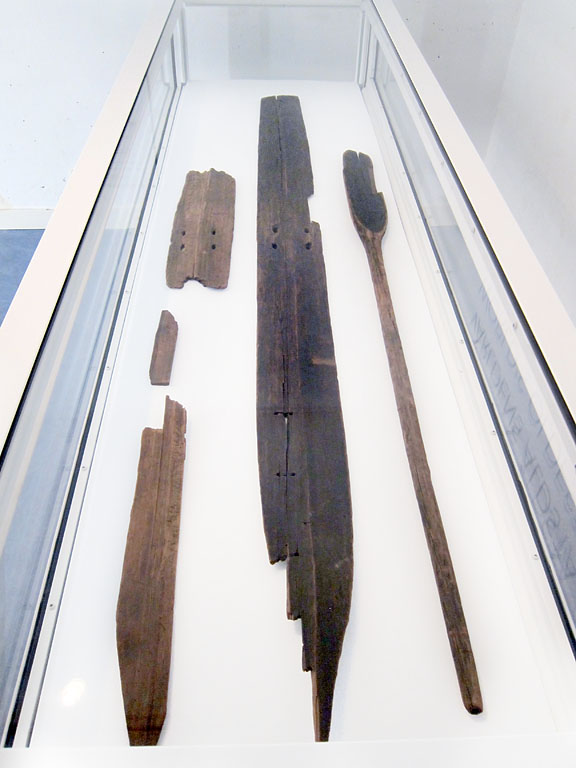
Stone age, 5,200 year old skis were accidentally uncovered from the coastal lowlands of a Swedish bog by a forestry inspector in 1924. Some ancient skis were purposely submerged in bogs during the summer in an attempt to preserve the wood from drying, splitting and warping. Drill holes were an attempt to fix a split in the wood. Larger holes allowed for bindings to be strapped to the feet.
The paddle shaped pole allowed the skier to scoop snow from an area, perhaps a campsite as well as push through the snow. A similar paddle shaped stick was found at the Star Carr archaeological site in Yorkshire, England and dated to an extremely early 8000 B.C. (or is it just a 10,000 year old dugout canoe paddle?) (Photo from Wikipedia) |

A 5,000 year old petroglyph of a skier in northern Norway remained carved in stone. Unfortunately in 2016, this artwork was marred by ignorance and no longer appears as it once did in the above photo. (photo from Smithsonian Magazine article)
|
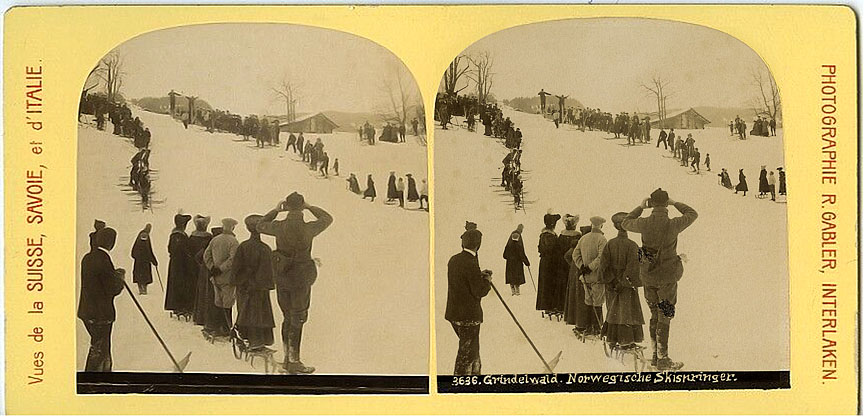
Skiing evolved from hunting and winter travel to more of a sport in Scandinavian countries as it spread throughout Europe and then later to Canada and the US.
In a 1880s stereoview photo, competitors ski jump in Norway as spectators stand on their sleds to watch and keep their feet off the snow and a bit warmer. (Stereoview Photo from Ebay listing) |
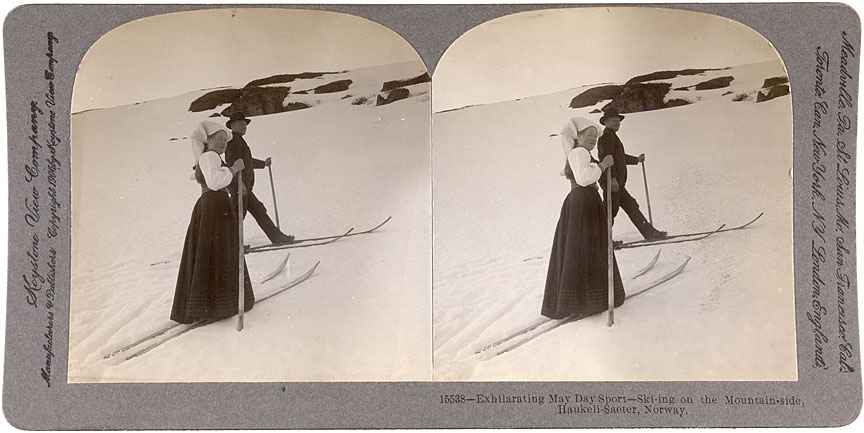
Standing at attention, a formal couple stand on Norway mountainside, each with a single pole and long skis. (Stereoview Photo from Library of Congress) |
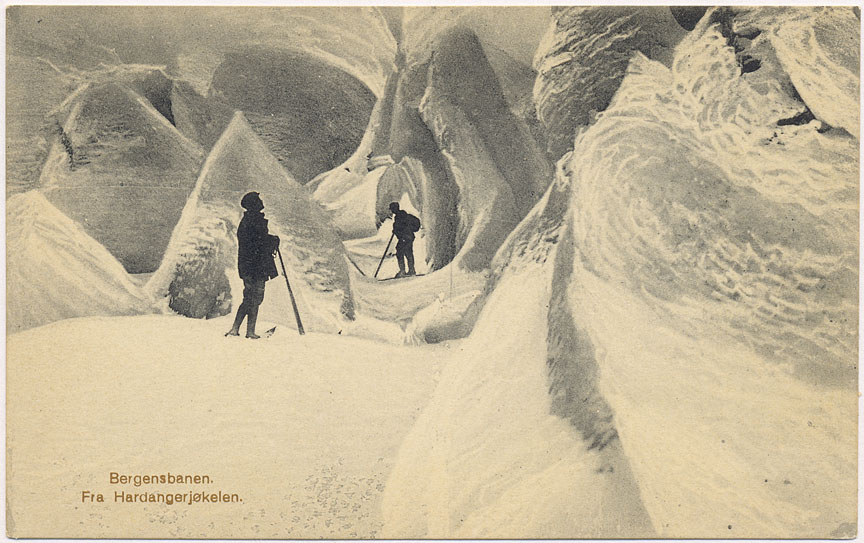
Skiing the Bergen Railway from Hardangerjokelen north of Oslo, Norway. (Parsons Collection) |

1932 - Ice ski races with horses, also known as skikjöring, takes place annually to this day on St. Moritz Lake in Switzerland. (Parsons Collection) |

Winter at the Grand St. Bernard in the Pennine Alps, Switzerland. The hospice for travelers between Italy and Switzerland was found in 1049 and was also a monastery. (Parsons Collection) |
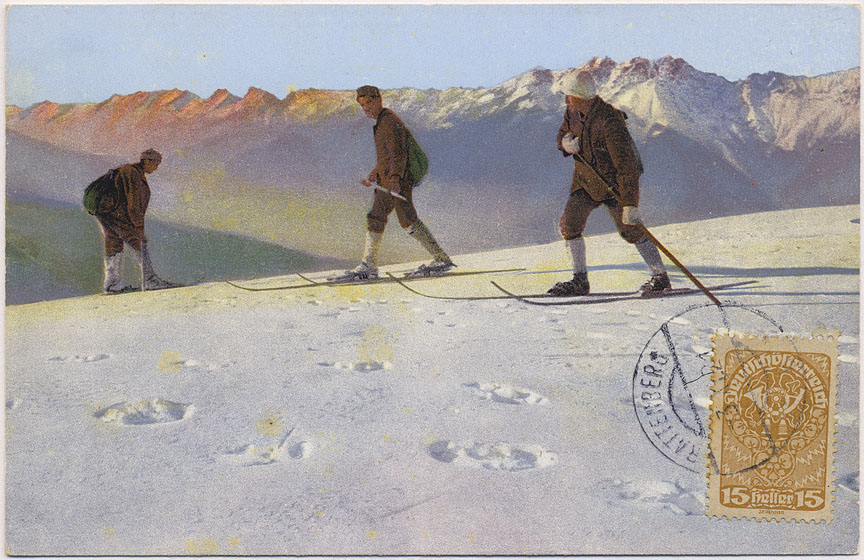
1921 - Snowshoeing and skiing northeast of Innsbruck in the Tyrol region of Rattenberg, Austria. (Parsons Collection) |
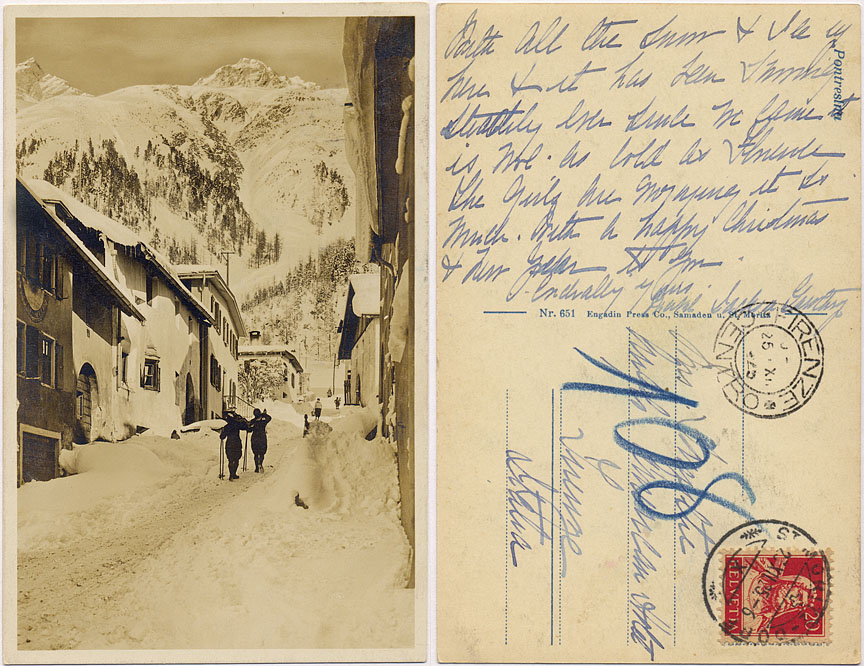
1925 - St Moritz lies near 5,900 feet in elevation in the southern Albula Alps of Switzerland. (Parsons Collection) |

1929 - Skiing over the frozen Lake to the Hospice of the Grand St. Bernard in winter at over 8,100 feet in elevation, Switzerland. (Parsons Collection) |

23 meter ski jump in Dauphine, France. Abandoned today, it was used in the 1968 Olympics and throughout events in the 1980s and closed in 1990. The hill record is 111 meters. (Parsons Collection) |
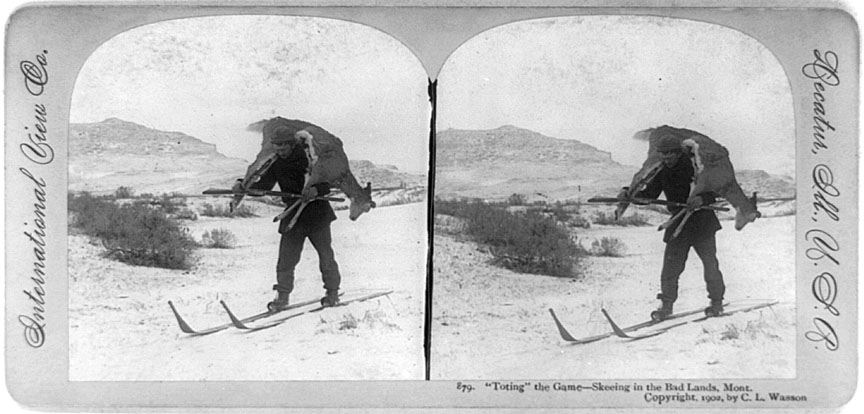
Skiing reaches North America and is used for hunting and winter transportation in Canada and U.S. and later gains popularity as a recreational activity. (Photo from Library of Congress) |
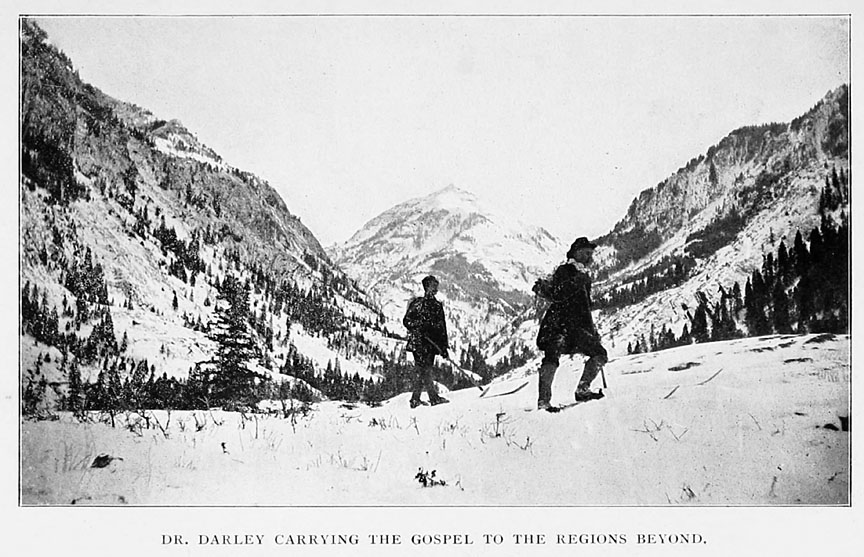
In George M. Darley's 1899 book Pioneering in the San Juan, the author, an itinerant preacher in the mining camps near Ouray during the 1870s, took nearly three hours skiing to reach the mining community after "eighteen inches of snow had fallen and the wind was blowing" (pretty standard Colorado conditions!). Previously, a man from a nearby camp had been "killed by a snow-slide while in his cabin" and another "died from exposure in storm." From Library of Congress
Earlier in 1864, another mail delivering itinerant Methodist preacher, John Dyer used his Noregian snowshoes to deliver 30 pounds of mail on a weekly 37 mile route that ran from the mining camps of Buckskin Joe and Mosquito over the Continental Divide to Cache Creek, California Gulch and back. |

Photo and excerpts from History Colorado's Summer 1969 Colorado Magazine "My First Year in the Gunnison County" by Harry C. Cornwall
(1879 - Early Colorado mining camp life)
"Practically everything that we ate was packed on men's backs from Teachout's (generally on our own backs). All traveling was, of course, on snowshoes. There were a few men who packed for hire. The tariff was fifteen to twenty five cents a pound but it was mankilling work especially as those professionals carried as much as one hundred pounds. We never carried over fifty pounds. Packing a load while walking on foot on a good trail is not to be compared with the same load while walking on skis and climbing up over a mountain pass at least three thousand feet. Very few men lasted more than a month at this professional packing, making a round trip a day (twenty miles each way).
The first forty day storm gave us about ten feet of snow on a level and this was added to every few days by fresh storms, but the sun and wind kept settling the snow so that at the deepest it was about fourteen feet. We arranged a platform about six feet square with an upright stick, in a sheltered spot where the snow would neither drift nor blow away. After a foot or two had fallen, and before it had had time to settle, we would sweep off the platform and record the depth of the snow that had fallen. The total fall for the winter recorded in this manner was eighty-four feet. This sounds incredible but it is true.
One of the most beautiful sights that can be imagined is a spruce forest on a bright sunshiny morning after a heavy snowfall where there has been no wind to blow the snow from the trees. We could look off across the valleys and mountains for miles, the trees simply loaded with snow and the contrast between the snow and the green of the trees in the bright sunshine made a most wonderful sight. Traveling through these spruce forests after a heavy snow on a bright day was not pleasant. As soon as the snow began to melt it would slide from the trees and huge masses, almost as large as a horse, would drop. Woe betide the unfortunate on which one of these landed. I have seen men actually knocked flat on the trail with much resultant profanity.
All travel, except from cabin to cabin right in camp was necessarily on snow shoes. We sent East to friends in Montreal for several pairs of regular Canadian web shoes but they were useless. The Colorado snow was so light and feathery that wearing these shoes, we sank below our knees and travel was simply impossible. Later in the winter the webs might have been used but the skis were much preferable. Skis were imperative and we were all busy making them. Fortunately, there was an endless supply of fire killed spruce timber available, which is the best timber in the world for these shoes. We were somewhat deficient in tools and especially in a proper device for bending the toes of the shoes. Fortunately, there were a few carpenter's tools in camp and by wrapping the toes of the skis in burlap and boiling them in our largest camp kettles we were able to make a pretty good bend for the toes.
Our first shoes for the soft snow were large, twelve feet long by four to four and a half inches wide. Later in the winter after the trails were packed and the snow had settled and crusted, the shoes were as short as seven or eight feet and three and one-half to four inches wide. At first, we were all clumsy and falls were numerous but it was not long before we became fairly skillful and could travel without much trouble. Within a short time there were regular ski trails between Ruby and Crested Butte and Teachout's ranch and we thought nothing of skiing down to the latter place (twenty miles) for a couple of square meals with fresh meat and potatoes and Mrs. Teachout's biscuit and syrup.
On level ground with a good ski trail one can travel much faster than on foot on a good road. We easily made the twenty miles to Teachout's in less than four hours…"
"…While there was not much ski racing or coasting during the first winter in camp following winters saw it a regular part of our program. Several of the camps held regular meetings with a series of races and one winter, Gunnison City did the same with contestants from all over the country. Our races were all simply straight slides down the side of a mountain. We knew nothing in those days of jumping or cross country contests; in fact, we had so much of the latter to do as a matter of business that it would not have appealed to us as sport if it had been suggested. Our courses were about half a mile long and down a slope steep enough to develop a tremendous speed. The best time for a half mile course from a standing start was about forty-four seconds. Falls were frequent but the snow was deep and fairly soft so no serious accidents ever occurred. Our skis for racing were differently prepared than those for traveling. It would hardly have been possible to travel on racing skis which would slip out from under one at every step. We spent hours rubbing bees wax on the bottoms of these skis and in polishing them with blocks of hard wood. The result was a surface as smooth and slippery as glass.
One winter after the railroad had reached Crested Butte we had some sort of a delegation of newspaper people in camp. Among them was Nellie Bly, probably the original newspaper woman of that name. We, of course, arranged some ski races for the entertainment of the visitors and they also tried their hands at the sport. Miss Bly, who was squired by John Phillips, the editor of our local paper, had quite a bad spill. In those days women did not wear trousers and legs were supposed to be sacred from the public eye. Miss Bly stood on her head and rolled over several times with quite a display of shapely limbs and lingerie. Phillips laughed boisterously. "Sir," said she, "I have seen enough of you to know that you are no gentleman." John was equal to the occasion. "Madam, I too have seen enough of you to know that you are no gentleman."
Traveling on snow shoes after the snow began to really settle in the Spring was impossible during the day. The snow by ten or eleven o'clock became so soft and sticky that it stuck to the shoes and at every step it would be necessary to lift the shoe with about twenty pounds of snow. It was not possible to slide the shoe along the trail as would ordinarily be done. Consequently, we did all of our traveling at night, waiting until the crust had frozen hard enough to hold us up on skis. This made ideal skiing and we could reel off five miles an hour with very little exertion. At each step we would slide two or three feet. Ideal skiing conditions would be a hard crust strong enough to support the skis without breaking through with about one inch of dry snow on top to prevent the skis from skidding." |
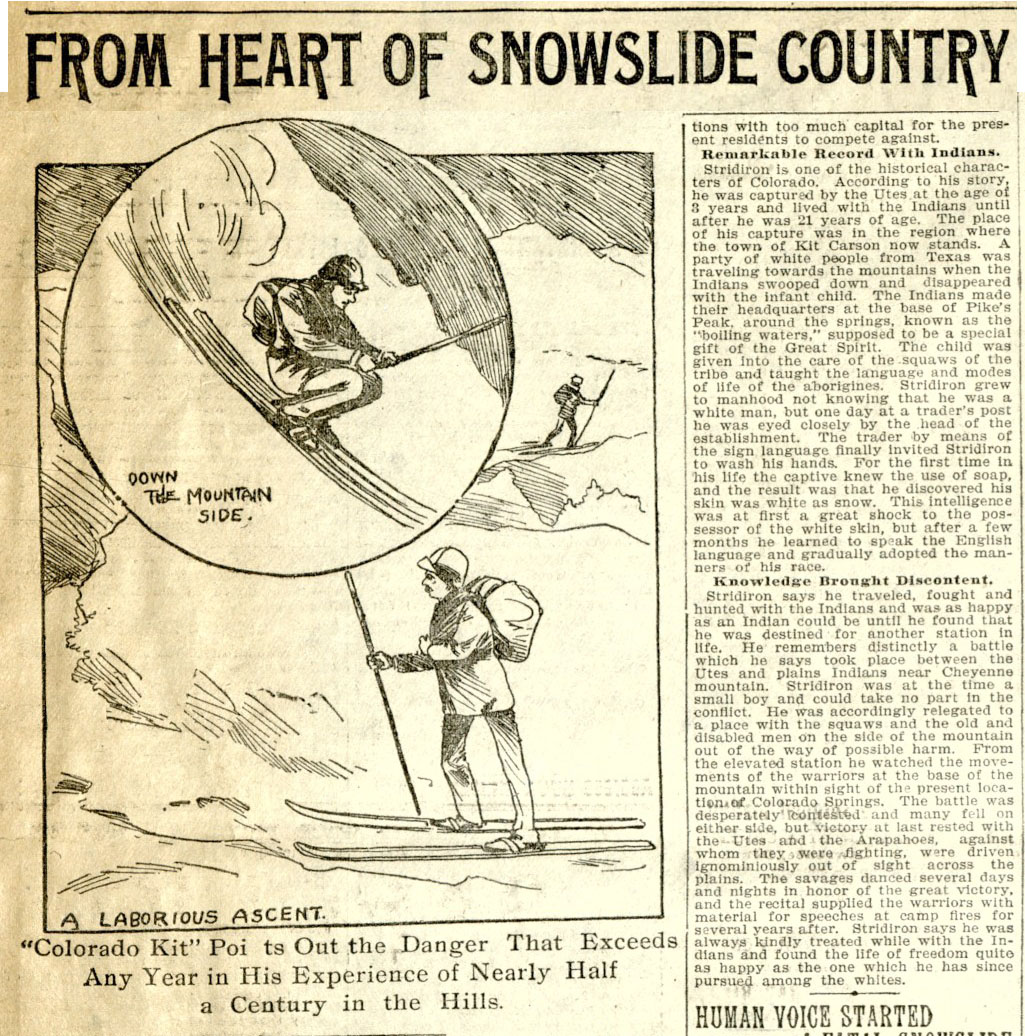
On February 20, 1899, the Rocky Mountain News reported about a Colorado resident, skiing through the mountains and through "the worst winter he ever saw" eventually reaching the city of Denver. In a way, he invented the first "mono-ski" when he "lashed the skis together and sat down on my heels with the guiding pole between and trailing just behind." (see above illustration) (Article from the Colorado Historic Newspapers Collection) |
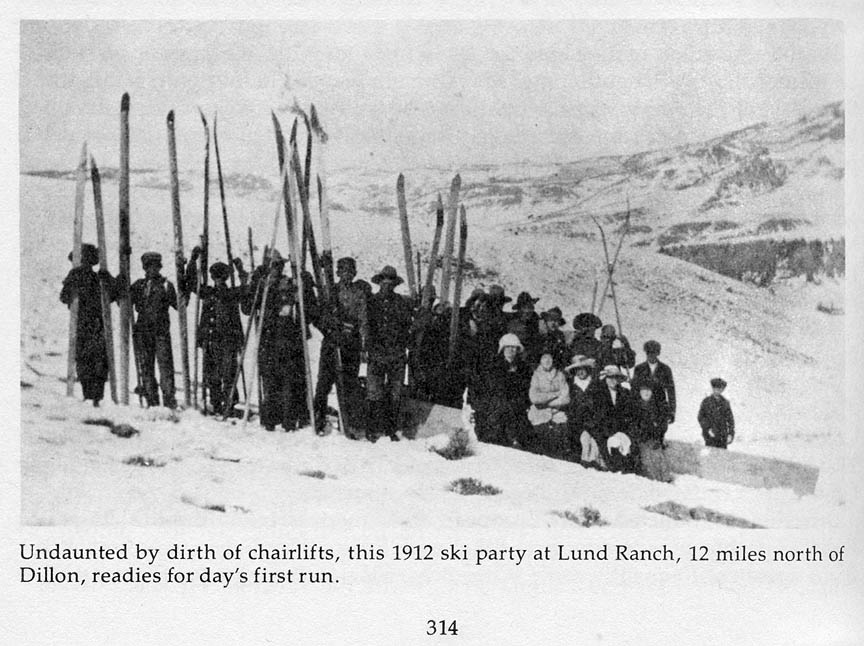
And I thought my 1990s garage sale K2 205cm skis were long! From Summit - A Gold Rush History of Summit County Colorado by Mary Ellen Gilliland - US Forest Service photo. |

Almost twice their height, a pair of ladies hold their eight foot long skis. Having skied on 205cm boards (6.7 feet), these must have been treacherous to to try and make a turn on. (Photo from Denver Municipal Facts - Denver Public Library Digital Collections) |
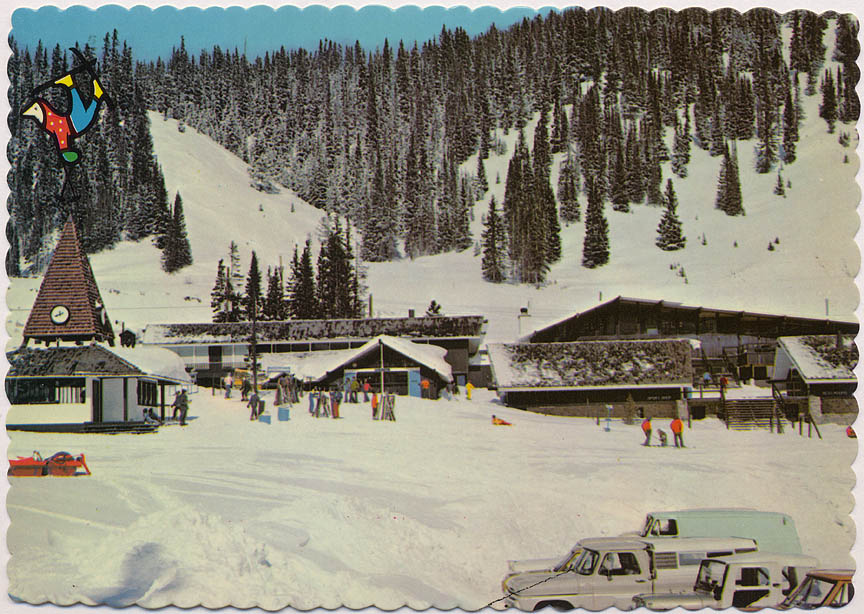
1960s - The parking lot, ticket booth, ski and rental shops and restaurant at Loveland Basin, Colorado. (Parsons Collection) |
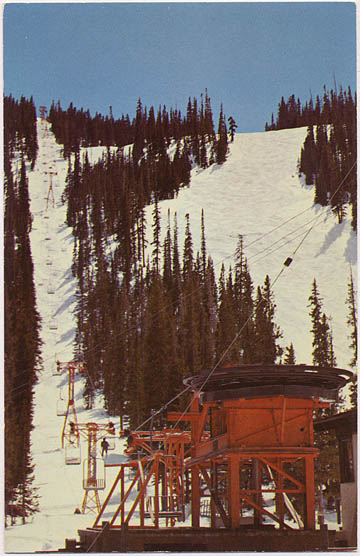
1960s - The twin chairlift at Loveland Basin, Colorado. (Parsons Collection) |
|

1958 Colorado vehicle license plate with a skier. (Photo from Ebay listing)
|
|

As climate change warms the planet and melts world wide glaciers, ancient artifacts are emerging from the ice. In 2021, with its leather binding intact, a 1,300 year old ski emerged from Norway's melting ice and joined it's mate, found years earlier in 2014 from the same area. Photos from Smithsonian Magazine.
|
|

After skinning up to the ridge, the author enjoyed powder telemark turns at a deserted Berthoud Pass in 2014 as snow fell.
One advantage of climate change may be the discovery of amazingly old artifacts, but as glaciers retreat and successive years become the warmest on record, what will happen to Colorado's and the world's wonderful snow?
|
|











